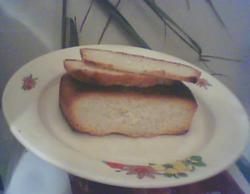 | |
| Type | Bread |
|---|---|
| Place of origin | Romania |
| Main ingredients | Wheat flour |
Lipie is a kind of bread from traditional Romanian cuisine. It is a round bread made with different wheat flour. [1]
The lipie has been known since the 16th century. It can be seen on some Romanian tapestries and in religious art. A lipie from the 17th century was discovered in a house in the medieval village of Dolhești, and it was named Dolhești's bread. [2]